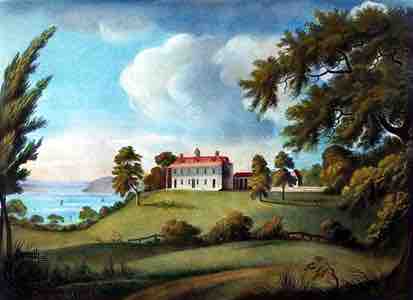The Mount Vernon Conference
On March 25–28, 1785, delegates from Virginia and Maryland met at George Washington's estate in Mount Vernon, Virginia. This meeting, which came to be known as the Mount Vernon Conference, preceded the Annapolis Convention of 1786 and was a precursor of the 1787 Philadelphia Convention that saw the drafting of the US Constitution. Its primary aim was to settle issues not addressed under the Articles of Confederation, including interstate cooperation.
The conference was attended by Samuel Chase, Daniel of St. Thomas Jenifer, and Thomas Stone of Maryland; and Alexander Henderson and George Mason of Virginia. James Madison and Edmund Randolph were also appointed as Virginia delegates but Virginia Governor Patrick Henry failed to inform them in time, so they were unable to attend.

George Washington's estate in Mount Vernon
Mount Vernon, aquatint by Francis Jukes, 1800
Issues Discussed
The delegates were charged with dealing with issues of commerce, fishing, and navigation in the waters of the Potomac River, Pocomoke River, and Chesapeake Bay. These issues were not addressed directly by the Articles of Confederation, which regulated the 13 largely independent states at the time, nor by the authorization of the Potomac Company a year earlier, which was to regulate the Potomac above the Great Falls.
The conference was largely a success and essentially created a model for interstate cooperation. A report was prepared for the two state legislatures in March 1785, containing 13 proposals known as the Mount Vernon Compact. Ratified by both Maryland and Virginia, it declared the Potomac, which was under Maryland's sole jurisdiction, to be a common waterway for use by Virginia as well. It also provided for reciprocal fishing rights, division of costs of constructing navigation aids, and cooperation on defense and cases of piracy. Lastly, it called for commissioners to deal with any future problems that might arise. The Mount Vernon delegates encouraged Pennsylvania and Delaware to join on to the agreement.
Implications
The conference was significant as a model of interstate cooperation outside of the framework of the relatively weak Articles of Confederation. Its success encouraged James Madison to advocate for further discussion of the limitations of the Articles and the constitutional issues facing the states, including trade and interstate issues and the limited power of Congress. While serving as George Washington's top aide, Alexander Hamilton also realized that a strong central government was necessary for avoiding foreign intervention and alleviating the frustrations caused by an ineffectual Congress.
On January 21, 1786, following the Mount Vernon Conference, Virginia invited all states to attend a meeting on commercial issues. This would later become known as the groundbreaking Annapolis Convention. In 1787, the Philadelphia Convention further expanded cooperation to include all states in an effort to reform or replace the Articles of Confederation with a new constitution.